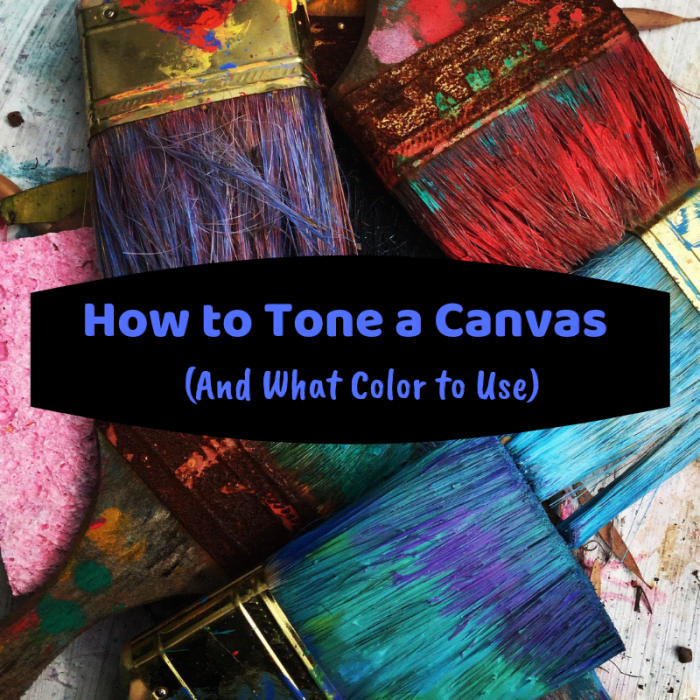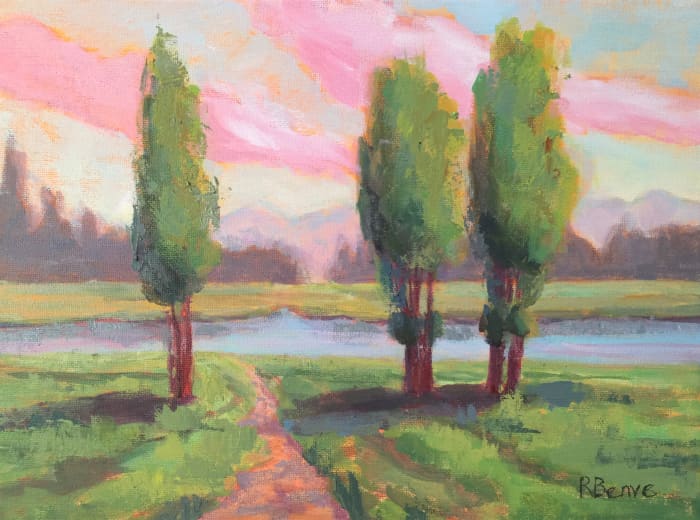Should You Paint A Canvas White First
Robie is an artist who loves sharing what she has learned about art and painting in the hope that it might help other creatives.

Toning a canvas is a great way to get rid of white space so you can dive right into the painting process.
RhondaK via Unsplash
Why Do Artists Paint on Toned Canvases?
An immaculate white canvas can be very intimidating. It is difficult to just dive right in and put a mark on its blank, even surface, but this is the first obstacle every artist needs to overcome before any painting can take place. The best way to start is to cover your entire canvas with thinned colored paint before beginning your piece. This process is referred to as toning your canvas.
Reasons to Color-Tone Your Canvas
- Beginning a painting with a ground color in place helps speed up the painting process.
- Since all white is covered during toning, starting the painting is less intimidating.
- Coloring a canvas ensures the painting's mid-tone is established from the start.
- The ground tone can help unify the final composition if you let specks of it peek through in your finished piece.
Why Not Paint on a White Canvas?
Generally, paintings do not look complete until every bit of canvas is covered with paint. Any remaining white space can detract significantly from the piece's impact.
Letting portions of the white canvas show through not only makes a painting look unfinished, but may also disrupt the viewer's attention and detract from the actual highlights you've painted into the scene.
A toned canvas can add vitality and sparkle to the final work and also helps harmonize the final painting.
— Kevin Macpherson

The fur of this brown dog is made of shades of orange and red. I toned it a bright, light green to create some contrast with the dog's color and harmony with the grass in the background. Acrylic on canvas.
Robie Benve Art, all rights reserved
How to Tone Your Canvas
Take a large splash of color and spread it all over the canvas. Cover the surface completely, and don't worry too much about the color or the look of the brushstrokes. The paint does not need to be evenly blended. Irregularity and variety in your paint stokes and thickness will add visual interest to the finished piece.
What Color Should Your Ground Tone Be?
You can tone your canvas using any color and value you like. You can even use multiple colors. Traditional base colors include yellow ochre or burnt sienna—these are highly recommended for beginners due to their versatility.
However, when choosing your ground colors, try not to be too predictable. Experiment with a wide array of complementary, harmonious, bright, and muted colors. Different bases can affect the overall look and feel of a painting, and experimentation is the best way to find winning color choices that suit your personal style.
When using something more adventurous or dominant, such as bright red, try spreading it thin. Let some of the white of the canvas come through to make it less intense. You can also switch between thicker and thinner paint as you tone different parts of your canvas.
Do you tone your canvases before painting on them?
What Value Should Your Ground Tone Be?
I usually aim for a medium-value tone, but exceptions can be made—sometimes they make the composition more interesting!
As rule of thumb, if you want to tone with more than one color or value, I recommend using staining that has the same values as the final design. Let the ground make your job easier. It is simpler to paint a light object on a light value and a dark object on a dark value. Try to let the ground be seen without compromising the visual unity of the mass.

This acrylic landscape painting was toned with orange to complement the green of the vegetation and to warm up the overall feeling of the picture. Acrylic on canvas.
Robie Benve Art, all rights reserved
Complementary Ground Tones
Complementary colors are opposite one another on the color wheel. These color pairs brighten each other visually when used in tandem or placed side by side. Toning with colors that are complementary to the intended color scheme of your painting will enhance its drama and richness.
Using complementary combinations in large applications can be very tricky as they often look kind of garish. They can, however, work extremely well together when one is dominant and the other is used very sparingly, like a ground that peeks through only here and there.
How to Apply and Acrylic Colored Ground
Harmonious Ground Tones
Harmonious colors are those that are next to each other on the color wheel and have some visual characteristics in common. If you prefer, you can tone your canvas with colors that are harmonious with, rather than complementary to, the colors of your intended subject.
Some examples of harmonious color sets are:
- yellow, yellow-orange, and orange.
- yellow-green, green, and blue-green.
Similarly, you could choose to use only cool colors or warm colors. Toning with a color that is harmonious to the hue of your painting's subject creates a sense of balance, order, and tranquility. However, it will produce little color-contrast and visual interest. When toning with a harmonious color, it may be a good idea to create excitement by emphasizing value differences and using textural strokes.

This black French bulldog is very feisty, so I chose an orange ground to portray vitality and to contrast the blues and purples of his fur. Acrylic on canvas.
Robie Benve Art,all rights reserved
Advantages of Bright Ground Tones
Brightly colored stains will:
- boost any muted or earthy paint colors.
- allow you to explore the boundaries of how colors interact when placed next to each other.
- evoke a particular mood or personality.
- come in very handy to brighten up a gray, rainy day scene.
- appear overly-dominant in the early stages of painting, but will later blend and interact with the layers above, creating a more balanced painting.
How to Paint Over Your Tone
Allowing touches of a brightly colored ground to show on the finished painting can enhance the overall richness of the picture, particularly if the ground color is complementary to the surface color.
As you build up your painting, more and more of the ground will get covered, but try to leave behind small fragments. This will provide a visual link between the different parts of the painting.
If you end up completely covering the ground color in some areas, you can always paint some small details using the ground hue on the surface later on to achieve that same sense of unity.
The Ground Tone Is Your Painting's Foundation
When choosing your ground color, it is very important to assess how the finished painting will look. Harmonious combinations are not very stimulating, and the viewer may lose interest quickly. On the other hand, clashing colors may get overstimulating, creating a chaotic and confused result.
Focus on value contrasts to create interest, and make sure you have a dominant color and one or more minor players in each piece. Good luck, and happy toning!
This content is accurate and true to the best of the author's knowledge and is not meant to substitute for formal and individualized advice from a qualified professional.
Questions & Answers
Question: Do you always use acrylic paint to tone your support before you start painting?
Answer: If I'm going to paint with acrylics I always tone with acrylics or with another water-based paint. Sometimes I use ink, sometimes I apply colored paper for a mixed media effect.
If I'm going to paint with oils, I may tone with oil paint thinned with odorless solvent. But sometimes I do the toning with acrylic and then proceed to paint with oils.
There is a lot of flexibility. The only rule you need to remember is to always apply "fat over lean".
You can apply oil over acrylic or water-based paint, but never the opposite. Acrylic over oil does not work. Once you start applying oils, you have to continue with them.
Question: I am painting a portrait with warm yellow tones. What would be a good color for the tones ground?
Answer: Maybe starting with a yellow ochre or burnt sienna ground will help.
Question: I would like to try toning a canvas but I'm not allowed to us turps since it is toxic and smells bad. Is there a way to tone it without using turps? Can I use nothing to thin the paint? And how do I do it? Thank you
Answer: In my experience, it's better if the toning is thin, so if you are using oils and can't thin with solvent, maybe you can consider toning with acrylics thinned with water. Oil is just fine on top of acrylic, the opposite would not work.
Another option would be to tone with oil paint right out of the tube, without any thinner, and let it dry for a few days, or until dry to the tough before you add more layers.
Question: When I am toning the canvas, is it recommended to paint a ground color that is complementary to the focal point or is it better to pick the same color as the focal point?
Answer: I like both options, either picking a ground color that is the same of the focal point or one that is its complementary, you can achieve a great effect both ways. It depends what you are after.
When in doubt, I would do a couple of color studies and see which one I like the best.
Question: I am working on a large canvas trying to create a beach scene from a photograph that incorporates a lot of red-orange in the ocean (no blue) and at the horizon. The sky fades to lighter tones of red-orange, and finally to a lighter shade with the sun going down, and a vanilla mixture with red-orange. What color would I use for the ground? If a complementary color, which one?
Answer: I would tone the canvas with colors that make your job easier. For the sky, a light, bright version of the main color, probably an orange. For the water a darker version of the main color. Maybe a dark red.
Then you paint the color of things over the ground. Make sure that right where the sun is setting you make it so light, and so bright that you almost want to squint looking straight into it. When painting te surface of the water, I usually alternate some cooler colors and some warmer colors, letting the ground peak through.
Question: I haven't tried toning yet, but I'm super new too. I am planning a stormy purple sky with lightning from a reference photo. It's almost all shades of purple fading into a light violet /pink with the lightning I want a complimentary yellow as it's kind of nod to a sports team. And finally, some trees that are black. What color might you suggest for the ground?
Answer: Since the sky you are going to paint is mainly purple, I would paint the canvas a mid-value purple. Then, while still wet, you can wipe off the purple where the lightening will be, and live that area lighter or stain it yellow. I hope this helps. You can also stain a darker purple where the trees are going to be.
Question: What is a good tone to paint a canvas for a beach scene?
Answer: I would go with a warm color, like a raw sienna.
© 2018 Robie Benve
kareem on September 09, 2020:
Thank you for toning guidelines .
Robie Benve (author) from Ohio on August 02, 2020:
Hi Nelvia, toning the canvas does speed up the process quite a bit, and avoids those annoying white bits of unpainted canvas showing up at the end. Thanks a lot for you comment.
Nelvia on July 29, 2020:
Sigh, something I should do more of. Thanks for the color ideas and the reminder as it does speed up the process and provides those rich mid-tones.
Robie Benve (author) from Ohio on June 11, 2020:
Hi Ravi, for an ocean scene, I would tone the area where the water will be with a color that is similar in value to the end result, maybe a little darker, and has deep turquoise-blue hints. If you use phtalo blue make sure it's dry before you paint over, or it will take over even in unwanted ways.
Ravi Rao on June 11, 2020:
What color should the underpainting be ideally for Turquoise-blue waves scene that I intend to paint in oil.
Luisa Hunt on August 27, 2018:
Seeing your paintings and how you handled the ground color, letting it show though really helped me understand the concept. Thank you so much for sharing!
Robie Benve (author) from Ohio on June 05, 2018:
Thank you Liz, I'm so glad to hear that you found my article helpful and informative. As a self-taught artist, I like to share what I learn about painting, and I'm always thrilled when I hear that others learn something from my writings. Thanks!
Robie Benve (author) from Ohio on June 04, 2018:
Hi Claudia, thanks a lot for stopping by and taking the time to leave such a nice comment.
Liz Westwood from UK on June 01, 2018:
This is a really helpful and informative article. I've learned a lot from reading this and the illustrations are great.
Claudia Mitchell on May 31, 2018:
I always enjoy your articles since I know next to nothing about painting. Your scene with the creek is absolutely stunning. I love the sky.
Robie Benve (author) from Ohio on May 29, 2018:
Hi galleryofgrace, I'm not sure how to read your comment. Do you really see this as a self-promotional article? I shared a few of my works to show examples of what I was explaining.
galleryofgrace from Virginia on May 29, 2018:
Good job promoting your own art work. Wonder how long the rest of us can get by with it!
Should You Paint A Canvas White First
Source: https://feltmagnet.com/painting/What-Color-Tone-Canvas
Posted by: hortonextob1973.blogspot.com

0 Response to "Should You Paint A Canvas White First"
Post a Comment